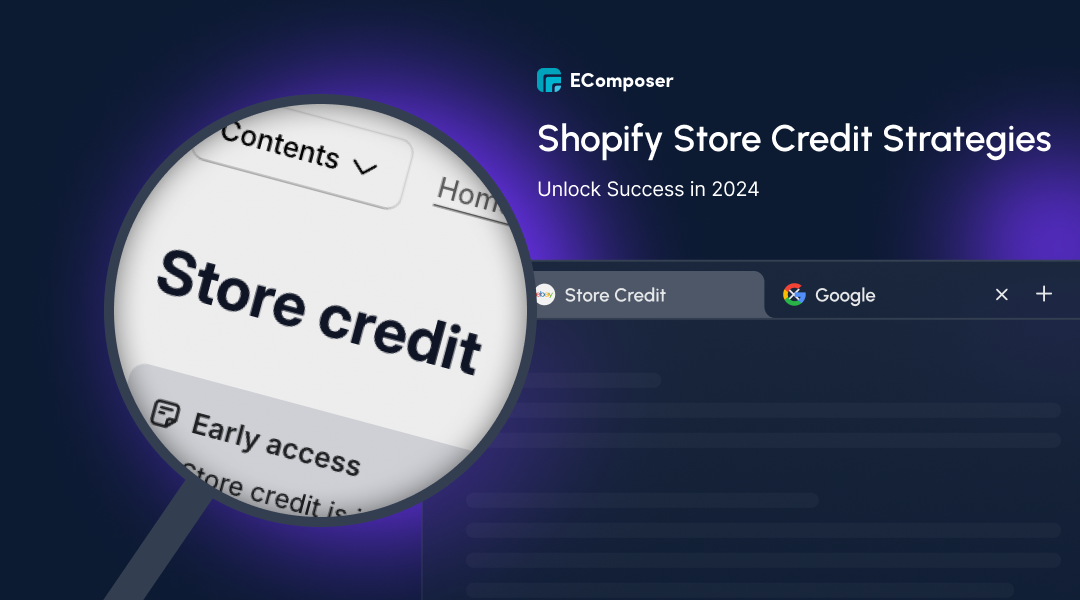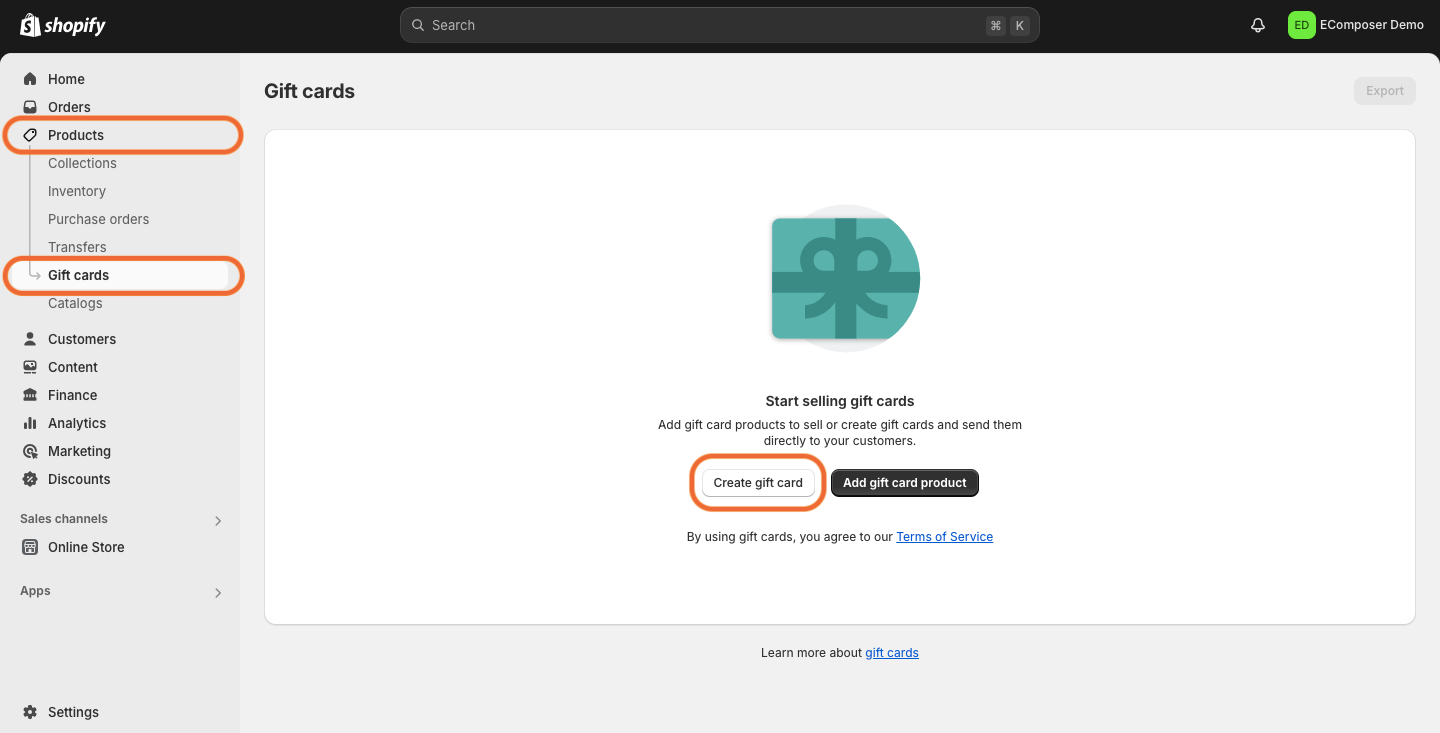Shopify Store Credit Strategies: Unlock Success in 2024

Table Of Contents
Store credit has become a powerful tool in e-commerce, enabling businesses to enhance customer loyalty and satisfaction. By offering store credit, merchants can create a more personalized shopping experience, encouraging repeat purchases and fostering brand trust.
Implementing effective Shopify store credit strategies will be crucial in 2024 for driving customer retention and boosting sales. With the right approach, businesses can unlock new opportunities for growth and ensure their Shopify store stands out in a competitive market.
What is Shopify Store Credit?

About Definition:
Shopify store credit is a term that describes a monetary amount that a Shopify store owner can give their customers to be compensated or make future purchases in the same Shopify store. Store credit can be used for several reasons, such as:
- Returns and Refunds: Instead of giving a cash refund, a Shopify store owner may give store credit to a customer so they can choose different products.
- Customer Loyalty: Regular customers might be rewarded with store credit to encourage them to come back and make more purchases.
- Gifts and Promotions: Shopify store owners may give store credit as a gift or as part of a promo campaign.
- Resolution of Issues: As previously mentioned, Shopify store credit can be used to settle customer grievances or issues and give them a credit to use in the future.
It is often managed via the Shopify platform, either by the business owner manually or by using applications from outside sources. Customers can use their store credit to lower the total amount of their order when checking out.
How to store credit works within the Shopify platform:
Online store credit gives users a digital balance to use to make additional online purchases. This is how it usually operates:
- Issuance: The online shop or business often issues store credit. This may occur for reasons like fulfilling consumer requests, loyalty programs, refunds, and returns.
- Digital Balance: Store credit is issued to customers and appears in their online account as a digital balance. The website or ecommerce platform's client profile is linked to this balance.
- Redemption: Customers can use their store credit balance at the checkout while purchasing. The whole order cost is subtracted from the available credit.
- Partial or Full Payment: Clients can use all or just a portion of their available shop credit when purchasing. If the purchase price exceeds the shop credit balance, the leftover credit is retained in the customer's account for future usage.
- Online Tracking: Thanks to the online platform's tracking and management of shop credit balances, customers may simply check their remaining credit and utilize it for future purchases.
- Limitations: Store credit frequently has rules and regulations attached to it. These include minimum purchase requirements, limitations on the items or services it can be used for, and expiration dates.
- Increasing Loyalty: Store credit may be a very effective technique for increasing customer loyalty and promoting repeat business by offering a reason for customers to return to the same online site.
In general, shop credit is a digital currency that encourages consumer interaction and facilitates subsequent purchases in the online sphere.
Why Store Credit is Vital for Success?

Improve customer retention and loyalty.
Store credit is a secret weapon for keeping customers coming back. Customers who receive credit instead of refunds have a compelling reason to return and shop again. This solves immediate issues and turns one-time buyers into loyal customers. Offering store credit sends a clear message: you value their business and want them to keep choosing your Shopify store, building a solid bond that boosts retention.
Encourage customers to spend more.
Store credit doesn't just bring customers back—it invites them to spend more. When shoppers have credit, they often treat it like a bonus, adding more items to their cart. Sales may increase as a result, as consumers frequently spend more than their credit limit. By encouraging additional purchases, store credit turns potential refunds into revenue growth opportunities.
Lose less revenue to returns.
Returns can eat your profits, but you can turn a refund into a future sale with store credit. Instead of losing money on returns, offering credit keeps that revenue within your business. By turning a possible loss into a growth opportunity, this method helps you retain a healthy profit margin while offering a great client experience.
Common types of store credit

Returns and exchanges
One of the most common ways to issue store credit is through returns and exchanges. Instead of offering a full refund, businesses can provide store credit. This approach ensures that revenue stays within the store and encourages customers to make additional purchases. For example, when a shopper returns an item, offering store credit alongside an exchange can boost the chances of a repeat purchase.
Store credit cards, financing, and layaway
Store credit cards, financing options, and layaway programs allow customers to make purchases and pay later. These are quite alluring choices, especially in light of the growing acceptance of "buy now, pay later" services such as Shop Pay Installments. By offering these flexible payment plans, Shopify stores can attract more shoppers, increase order values, and keep customers returning.
Gift cards
Gift cards are a straightforward form of store credit. When customers purchase a gift card, they buy store credit that can be redeemed later by themselves or someone else. Gift cards are a flexible and appealing choice for companies and customers since they may be used to hold credit from returns or as part of loyalty awards.
Loyalty rewards
Providing store credit through loyalty programs is another effective strategy. You may promote recurring business and raise client lifetime value by giving loyal consumers points or credit for every transaction. With the gift of shop credit as a thank you for their loyalty, these programs successfully maintain your top customers' interest and encourage more purchases.
How to Issue Shopify Store Credit
Method 1: Use Discount Codes to Issue Shopify Store Credit
Step 1: Open the Shopify admin and log in.
Begin by navigating to the Shopify website and logging into your store's admin dashboard using your credentials. This gives you access to all store settings and customer information needed to manage your store credit process.

Step 2: Access the customer's profile.
Once inside your admin dashboard, head to the "Customers" section in the left-hand menu. Use the search bar to find the customer to whom you want to issue store credit by entering their name, email address, or other identifying details. This will provide a list of pertinent client profiles.

Step 3: Edit customer details.
Click on the correct customer's name from the list to open their detailed profile. You'll find all their past orders, contact information, and any existing notes or tags here. This is the section where you can manage their store credit.
Step 4: Add a note.
In the customer profile, scroll down to the "Notes" section. This area allows you to add essential details related to the store credit, such as why it's being issued and the exact amount. Documenting this information ensures you have a record for future reference and helps maintain transparency in your customer interactions.

Step 5: Issue store credit.
To manage customers with store credit more easily, go to the "Tags" section of the customer's profile, typically near the top. Add a relevant tag such as "Store Credit" or "Credit Issued." This tag will allow you to filter and search for customers with store credit in the future, streamlining your operations.

Step 6: Apply a discount code.
If you want to provide the customer with a redeemable discount code as their store credit:
- Go to the "Discounts" section in your Shopify admin.
- Click on "Create Discount" and choose the type of discount you want to offer.
- Set the discount amount to match the store credit you're issuing (e.g., $25 credit equals a $25 discount).
- Customize the discount's conditions, such as usage limits or expiration dates.
- Once created, copy the discount code and prepare to send it to the customer.


Step 7: Notify the customer
After everything is set up, contact the customer to inform them about their store credit. You can do this through email or by contacting them through their preferred communication channel. Provide clear instructions on how they can use their store credit, including the discount code if applicable and any conditions or expiration dates tied to the credit. This ensures the customer knows how to redeem their credit on future purchases.
Method 2: Use Gift Cards to Issue Shopify Store Credit
Step 1: Navigate to the Gift Cards field
After logging into your Shopify account, head to the "Products" section on the left-hand menu. From there, select "Gift Cards." This section allows you to manage all gift card-related activities, including issuing and tracking them.
Step 2: Choose an Issue gift card
Once in the "Gift Cards" section, look for the option to "Issue gift card." By selecting this option, you can personalize the gift card by choosing the recipient and adjusting the amount. This is where you enter the details of the store credit you're providing.

Step 3: Activate the gift card
After entering all the necessary information, finalize the gift card by clicking "Save". This action makes the gift card live and available for the recipient. The gift card functions like currency within your store, allowing the customer to apply it to future purchases.

Recommendation Third-Party App to Give Shopify Store Credit
AfterShip Returns & Exchanges

With an automated returns system, you can provide a flawless customer experience, increase customer happiness, save time, and recover income. Encourage customers to swap rather than return items to compensate for lost income. You can improve efficiency by controlling returns, monitoring insights, and establishing automated rules all through one interface. Automated email alerts and branded returns pages may ease consumer worry. Utilize carrier data and regional return routing to manage carriers effectively and react fast.
Key Features:
- Email alerts and a self-service returns website can ease customers' concerns.
- Refundable products and the returns window are clever return policies that reduce returns.
- Adaptable exchange and refund policies to satisfy clients and recoup costs
- To cut down on manual labor, automation rules like auto-refund and auto-restock
- Warehouse and carrier settings for an efficient and affordable package return and restocking
Rise.ai: Gift Cards & Loyalty

For eCommerce companies, Rise.ai is the preferred Gift Card and store Credit platform. It offers cutting-edge solutions for managing store credit, selling gift cards, incentives, referrals, refunds, and loyalty schemes. Use our tools to raise client LTV and retention rates. Give your customers Store Credit rewards in simple, comprehensible monetary amounts as an alternative to points. Additionally, you can leverage Rise's omnichannel solution to reward consumers every time they make a purchase by integrating with Shopify POS.
Key Features:
- Returns & Refunds: Give store credit for returns and refund gift cards.
- Bulk Gift Cards: ideal for employee appreciation, corporate gifting, or relocation needs.
- Gift Cards: Customers may receive, schedule, and be notified about gift cards.
- Loyalty: Start a proactive program that guarantees the accrual of shop credit.
- Workflows: Based on consumer activities, initiate and generate shop credit awards.
LL: Loyalty Referrals Rewards

Increase client loyalty and recurring business with Loyal's effective rewards, discounts, and referrals (refer a friend) program. With ease, launch Loyal and take advantage of its cutting-edge features, which include point systems, referral programs, and personalized rewards. You may expand your shop and boost marketing prospects with the correct customer loyalty program. Import data from other applications such as Smile.io, Growave, Yotpo (Swell), Joy (Joyio), BON, and Loyaltylion to access even more value.
Key Features:
- Encourage repurchases and interaction by offering a variety of incentives and VIP levels.
- Users of memberships that foster community, loyalty, and trust should be rewarded.
- Set up with special links and vouchers for affiliate programs and referral campaigns.
- Employ various incentive strategies, including shop credit, discount codes, and giveaways.
- Increase the value of your client base over time with our Loyalty (Loyalty royalty) program.
Return Prime: Return → Revenue.

Return Prime: Return → Revenue is an all-inclusive solution made to assist companies in centrally managing their refunds, exchanges, and returns. The app's user-friendly design makes it easy for businesses to use and gives customers a seamless, rapid return experience.
Key Features:
- Customizable Return gateway: This feature lets companies customize the return gateway to reflect their logo while maintaining a user-friendly interface that is nice to customers.
- Automated Return Labels and reimbursements: By eliminating human mistakes and saving time, merchants may automatically provide consumers with return labels and reimbursements.
- In-Store Returns: By facilitating in-store returns, businesses may add convenience for their consumers and increase in-store traffic. This is made possible by the app.
- Support for Multiple Languages: This feature, available in various languages, increases inclusiveness by serving a more extensive client base.
- Clever Exchanges: The opportunity to swap returns for new ones encourages consumer loyalty and helps hold onto sales.
Parcel Panel Returns & Exchange

Reduce returns to turn disappointment into a chance. With a self-service returns center, email alerts with real-time progress updates required shipping instructions, and return labels, Parcel Panels' solution lets you provide consumers with peace of mind. To promote exchanges and prevent lost sales, centralize the administration of returns and exchanges and personalize your return solutions. The greatest substitute for AfterShip Returns, Return Prime, Returnly, and ReturnGo can transform returns!
Key Features:
- Set eligibility requirements, acceptable justifications, and acceptable proof to stop fraud.
- Simplify Exchanges and Returns using Return Page, Return Portal, and Return Prime.
- Proactive email notifications, flexible product swaps, and reimbursements.
- Sendcloud, Shippo, and smooth return label auto-generation integration are included.
- Automatically syncs loop returns status to Shopify and connects seamlessly with Shopify.
Best Practices for Managing Shopify Store Credit

Effectively managing Shopify store credit involves key best practices to enhance both efficiency and customer satisfaction.
Setting clear terms and conditions is essential for avoiding misunderstandings. Make this information widely available on your website and in client correspondence by clearly outlining expiration dates, use limits, and other pertinent facts.
Automating store credit management streamlines the process. Use Shopify's integrated tools or third-party apps to handle issuing, tracking, and expiring store credit. Operations run more smoothly when there is less manual labor and fewer mistakes due to automation.
Tracking and analyzing the impact of store credit helps gauge its effectiveness. To track KPIs like redemption rates and repeat purchases, make use of Shopify's reporting services. You might be able to utilize the facts to strengthen your plan since they might offer significant new insights into the connection between shop credit and sales as well as consumer loyalty.
FAQs
Is there a limit to how much store credit a customer can accumulate?
Although there isn't a default cap on how much shop credit a client may accrue on Shopify, it's a good idea to create your own restrictions depending on your company's needs. Maximum credit thresholds can be set in order to control the financial health of your shop and avoid overaccumulation.
Can I monitor how well store credit is driving up sales?
Yes, you can track the effectiveness of store credit using Shopify's reporting and analytics tools. Monitor redemption rates, average transaction values involving store credit, and repeat purchase rates. You may learn more about how store credit affects sales and consumer behavior by analyzing this data.
How should I communicate store credit policies to customers?
Communicate store credit policies through multiple channels. Make sure the terms and conditions are included in the checkout process and are clearly visible on your website. Additionally, send confirmation emails or notifications when store credit is issued, outlining how it can be used and any relevant expiration dates.
What are some common challenges when implementing store credit, and how can I address them?
Common challenges include managing credit expiration, preventing fraud, and integrating credit with promotions. To address these issues, set precise expiration dates for store credit, use robust tracking and security measures, and ensure your system can handle store credit in conjunction with discount codes and promotions.
Can customers use store credit with discount codes or promotions?
Yes, customers can generally use store credit alongside discount codes or promotions, but this depends on your store's policy. Configure your Shopify settings to allow such combinations, and clearly outline any restrictions in your store credit terms to avoid confusion and ensure a smooth checkout experience.
Read more:
- Top 11 Shopify Store Credit Apps Free
- How to Test Shopify Credit Card Payments
- [10+] Best Payment Methods for your Shopify stores
- Shopify Test Payments: The Ultimate Guide!
Conclusion
Leveraging Shopify store credit can significantly enhance your e-commerce success in 2024. Customer loyalty may be successfully increased and sales growth can be accelerated by establishing clear regulations, automating credit management, and measuring its effects. By putting these tactics into practice, you can facilitate a smooth shopping experience and promote repeat business.
The best time to implement these strategies into your Shopify store is right now. To increase client interaction and boost sales, embrace store credit. It is highly recommended that you investigate the possible advantages of store credit for your business or offer firsthand accounts. Let's work together to make 2024 a very successful year for your online store!



















0 comments